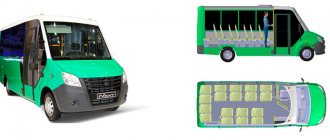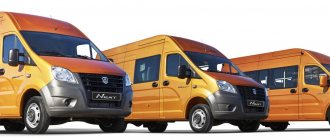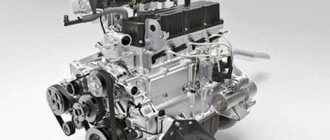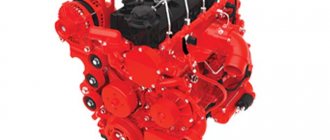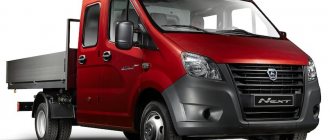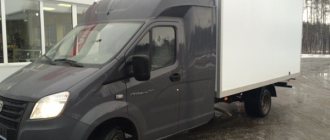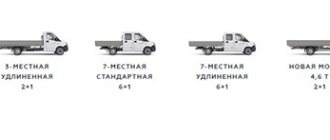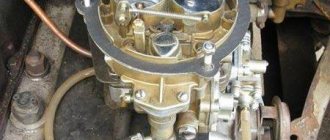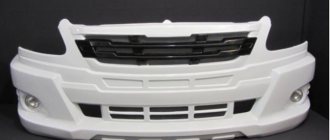Cummins ISF 2.8 diesel engine
The Cummins ISF 2.8 diesel engine began to be installed on Gazelle Next from the moment the production of these cars began, and now all cars of the Gazelle Next series are produced with this engine.
The unit complies with EURO-4 standard. The resource declared by the manufacturer is 500 thousand kilometers. I must say, a pretty good figure. The modern engine design ensures that current and future environmental requirements are met with minimal design complexity. High torque and optimally selected transmission ratios provide high dynamics and allow operation without extreme loads on the vehicle chassis in the most extreme conditions (maximum load, difficult road conditions).
Perhaps the only negative is its Chinese assembly. The Next engine is assembled in China, from where it goes to the factory to install the car. But the parts and components themselves are not made in the Middle Kingdom. The supplier is American.
Characteristics
| engine's type | 4-cylinder turbodiesel |
| Maximum power, hp | 120 at 3600 rpm |
| Maximum torque, Nm | 270 at 1400-3000 rpm |
| Engine volume, l | 2,8 |
| Compression ratio | 16,5 |
| Cylinder diameter, mm | 94 |
| Piston stroke, mm | 100 |
Reviews of the Cummins ISF 2.8 engine for Gazelle Next can be found on our forum.
Conclusion
The Cummins Gazelle engine has established itself as a reliable and easily repaired power unit. The engine size allows you not only to obtain the necessary power, but also to be quite economical with an average consumption of 10 liters for every 100 km.
The engine design is quite simple, which allows you to carry out repair and restoration work yourself without any problems. As for the oil pump, turbine and fuel injection pump, it is recommended to repair them at specialized service stations, since the design is quite complex.
Gasoline engine UMZ EvoTech 2.7
The Next Gazelle with the EvoTech 2.7 engine began production in 2014 and now most models can be purchased with this gasoline engine.
Leading designers of the GAZ Group and the South Korean giant Tenergy, a leader in the field of creating power units, took part in the development of the EvoTech 2.7 engine. The gasoline engine is designed for at least 400 thousand km, and it comes with a warranty of 3 years or 150 thousand km. The EvoTech engine compares favorably with earlier analogues produced at UMP.
The new engine consumes 10% less fuel, torque has increased significantly, and traction and dynamic characteristics have improved. All these improvements are made without harming the environment and cost: EvoTech 2.7 meets the high requirements of Euro-4 and Euro-5 standards, and has the lowest cost of ownership among analogues.
The improvement in traction and dynamic characteristics looks truly impressive, since it was possible to reduce the volume from 2.9 to 2.7 liters. The power characteristics did not deteriorate, since it was possible to reduce mechanical and thermal losses by changing the valve timing. The introduction of a new form of water jacket and modification of the cylinder head made it possible to increase the efficiency of the cooling system, while improving the thermal efficiency of the engine.
The developers have improved the main components and parts of the engine. Among the innovations are a new design of pistons, cylinder block, camshaft and combustion chamber. The electrical equipment of the engine has changed significantly, as well as sealing connections, fastenings of a number of components, cooling systems, ignition, power and lubrication. All improvements are made within the framework of the traditional four-cylinder 8-valve design.
Characteristics
| engine's type | Four-stroke gasoline engine with integrated microprocessor fuel injection and ignition control system |
| Maximum power, hp | 106.8 at 4000 rpm |
| Maximum torque, Nm | 220.5 at 2350 rpm |
| Engine volume, l | 2,7 |
| Compression ratio | 10 |
| Cylinder diameter, mm | 96.5 |
Reviews of the UMZ EvoTech 2.7 engine for Gazelle Next can be found on our forum.
Source
Design and principle of operation of the motor
It is necessary to start with the fact that the Cummins engine is very unpretentious to fuel. This became possible thanks to a new, modernized fuel purification system. The power unit is equipped with a new CommonRail fuel supply system. In this case, fuel is supplied directly into the combustion chamber under high pressure.
As for the gas distribution mechanism, everything is very simple and reliable. The cylinder head gasket consists of several steel sheets, which prevents it from burning out quickly, unlike other diesel engines.
The engine, which is mounted on the Gazelle, is equipped with a 4-valve gas distribution system, which ensures maximum technical characteristics and the required power. The timing chain has a chain with a tensioner, which ensures the reliability of the mechanism and sufficient strength. The camshaft is located according to the classical design.
Checking valve clearances should be carried out every 80,000 km, but valves need to be adjusted every 250,000. The standard valve clearance is: 0.38 mm for intake, and 0.76 for exhaust.
The fuel pump has a rather complex structure, which almost reduces the possibility of repairing it at home to zero. But, due to its reliability, it uninterruptedly provides high pressure, which is 1800 bar.
Also, an electronic controller is installed, which provides quality control of the fuel supplied to the injectors.
As for the cooling system, it is closed and can be configured for operation in different weather conditions. This becomes quite convenient since there is a significant difference in engine operation in warm and cold regions.
Gazelle Next or how hard it is to choose a commercial vehicle
GAZelle in our country is not just a car. The Gazelle is the hero of jokes about minibuses always rushing to a stop, the GAZelle is an ambulance, the GAZelle is a car for law enforcement agencies, and finally, the GAZelle is a breadwinner car for a very large number of people.
My first acquaintance with the GAZelle happened long before I had a driver’s license. It was a well-breathing, well-worn flatbed gasexus with a single cabin. They squeezed everything out of the car that it could give, and my friend’s father bought it for cheap in order to transport iron for ferrous metal.
From time to time it turned out that Pakha and I drove this gazelle, and every time a trip to the prima scrap station could end with the car having to be left there. In my memory, it constantly had problems with the carburetor, fuel pump, once the splines on the axle shaft of the bridge were cut off, and it could only be started by making a sacrifice to the Nebligol God, going to the store, buying some kind of piece of iron and screwing it to the GAZelle.
Then, as I grew up, I went to work at a construction site, and the GAZelle became my constant companion, since they took me to work on it, they brought us materials for work on it, and they brought us lunch on it. And these were much more decent specimens, with sixteen-valve injection engines, and they didn’t have to be started for half an hour, which was very pleasing. Again, being a very inquisitive young man, I did not miss the opportunity to drive these cars, because experience is experience.
But time passed, and in 2013 the GAZ Group released a new, third generation of GAZelle Next cars. Although this car is a modernized GAZelle Business, these modernizations made these cars completely different, and now, taking into account all the changes, the new light Domestic truck, already in full, without any exaggeration or additions, can compete with its classmates because hillock, and GAZelle Next will cost much less.
The frame of the car remained the same, but it was modernized in places where it was extended, and now it won’t break in half... well, if you don’t overload the cars.
To be fair, I want to say that in all the time these cars have been driving around Russia, I don’t know of a single case when they had problems with the frame, which were quite common at Businesses. Although absolutely everything, both “Nexts” and “Businesses”, has been and will be overloaded.
The flatbed version without extension has a length of 5630 mm with a load capacity of 1440 kg, and the “long” GAZelle Next has a length of 6709 mm, and the load capacity is reduced to 1270 kg.
In addition to the flatbed version, there is also an all-metal van, which can be a cargo van, a cargo-passenger van, or a regular minibus with 19 seats.
Regardless of the options for what is put on the frame, technically the car remains unchanged.
The car is equipped with three types of engines: gasoline, 2.7 liters; the same engine, but in addition to gasoline, configured at the factory to work with LPG, and finally - a Cummins diesel engine. I don’t want to talk today about gasoline engines on these cars, simply because it is an absolutely stupid idea to put a stunted gasoline engine in a truck. This car needs a diesel! Everything else is Satanism, unless we're talking about V8s from Toyota sedans, but that's a completely different story.
The Cummins ISF 2.8 engine is an Asashai-developed unit, which is currently actively supplied to all countries of the world from China, where it is produced in the city of Xi'an, Shaanxi Province. This is an inline four, with a displacement of 2.781 liters. The motor has a block made of gray cast iron, and it is lined with liners milled, thanks to which worn liners can later be replaced with new ones, which is a very rare occurrence for modern engines, since maintainability has long been of no interest to any automakers. The block is crowned with an aluminum cylinder head with a single camshaft, the valves are driven from heat-resistant steel by rocker arms, the timing chain is driven by a single-row chain, the tension of which is regulated by a hydraulic tensioner with two “shoes”. The manufacturer claims that the entire timing drive is maintenance-free and is designed for the entire service life of the engine, which again, according to the manufacturer, is 500,000 km. To lighten the load on the timing drive, the injection pump manufactured by BOSH is driven by a gear from the crankshaft. Since there are no hydraulic compensators in the cylinder head, it is necessary to adjust the valve clearance once every 150,000 km.
The engine is equipped with a Holset HE 200 WG turbocharger, which blows into the engine with a pressure of 0.5 bar. The air pumped by the turbine is cooled in the intercooler.
Power system - Common Rail manufactured by Bosch. The car is already standardly equipped with a pre-start liquid heater, heated intake manifold and fuel filter.
The unit has a power of 120 hp. at 3200 rpm and a torque of 297 N*m, which is available in the range from 1600 to 2700 rpm. It is also worth noting that the engine can very miraculously be chipped to 160 horsepower and almost 400 torque without loss of service life.
The motor can safely be called very successful, but it is quite unpretentious, but, like all motors with Bosch Common Rail, it is demanding on fuel quality. Simple recommendations for the Cummins ISF 2.8: fuel from proven network gas stations, good oil, with a replacement interval no later than 10,000 km and... that’s all. Subject to these simple conditions, this engine travels the 500,000 km promised by the manufacturer without losing factory characteristics, which is a very good result.
In order for the transmission to handle the noticeably increased power, a reinforced clutch basket and clutch disc were installed. The five-speed gearbox has also undergone a number of changes. All bearings were replaced with Swedish SKF ones, and synchronizers were replaced with German ones from Hoerbiger. The approach to processing the metal of gears has also changed; thanks to grinding of the teeth, the box has become more comfortable for switching, and its strength has increased. All rubber parts are from Ruben and Simrit.
One innovation for the GAZelle is the front two-link independent suspension with anti-roll bar, which is assembled on a massive subframe, instead of beams and springs. This ensured a very smooth ride when driving on the highway, but according to experienced Gazelle drivers, the old suspension on GAZelles was much more durable.
The rear suspension of the GAZelle NEXT consists of four springs, the top two of which are elliptical, shock absorbers from the Korean company Mondo, and an anti-roll bar.
Changes also affected the steering. Now there is a ZF rack with a hydraulic booster, thanks to which there is now no need to have good physical training to work on a GAZ car... well, the maneuverability of the car now deserves only applause, since it only takes two turns to turn the wheel completely.
The brake system also received innovations. According to the manufacturer, the braking reserve on the GZAel NEXT is as much as threefold. To be fair, it is worth noting that the car actually stops very well, regardless of whether the car is loaded or empty. Such worthy indicators were achieved by installing more efficient brake mechanisms from the Korean company Mondo, which seat more heat-resistant ventilated discs on the front axle and drums at the rear, a GTZ with a vacuum booster from Bosch, and an ABS module from the same manufacturer. The car was also equipped with ESP and ASR stabilization systems.
Getting behind the wheel of this car after, for example, a Ford Transit, the unsightly angular interior of the NEXT will only cause a yawn, but if you transfer from a GAZelle business, the difference will be obvious, as they say.
The seating position has become more comfortable, the steering wheel has become more comfortable, the pedals are pressed softly, there are enough different drawers, cup holders and niches for various types of gear, which the driver needs on long trips.
This car is now really convenient to drive long distances, and to travel without refueling thanks to the 80-liter fuel tank; with cruise control, long distances are not a chore, as it was on the Business.
The car moves very well on asphalt at a speed of 110 km/h, and neither a side wind nor a “washboard” on the asphalt can knock it off its trajectory. Keeping in mind what it’s like to overtake with a consumptive gasoline engine on a loaded GAZelle, I made the first overtaking on the diesel NEXT with great caution, carefully choosing the distance to the oncoming car, but after a couple of overtaking I realized that the Cummins engine was enough to in fifth gear, having a ton of cargo in the back, you can easily overtake, and without any problems you can accelerate from 90 km/h to 120. The engine pulls and pulls well.
The engine has enough thrust to maneuver in first and reverse gears in a parking lot without touching the gas pedal. This is what gasoline GAZelles lack so much.
In general, GAZelle NEXT is the most wonderful commercial vehicle that can be bought within 1.2 million rubles... but with a number of reservations.
After reading everything written, you might think that the car has absolutely no problems, but this is not so. Well, the very first thing that someone who buys a car produced by the GAZ Group will have to deal with is the GAZ Group itself, whose dealers work as if they were highway bandits. All sorts of minor and not very warranty repairs will have to be proven, since usually GAZ DC simply ignores such requests, or they write everything off as improper operation of the car. Of course, it is not uncommon for a car to be overloaded at twice the permissible limit, which causes the engine, transmission, and chassis to suffer. But it also happens when a person did everything as required by the manufacturer, and the devil sends him... um... home. In the event that warranty repairs are agreed upon, then the DC will not have spare parts, which will need to wait from two weeks to a month, when the same driveshaft crosspiece will always be in stock in the “Machine Parts” window. Why is that? Well I do not know. This is probably their unique style, which with all its nature screams that you should not repeat such a mistake as buying a car produced by the GAZ Group, or at least not go to them for maintenance and, in general, forget about the factory warranty.
Although the manufacturer stated that it galvanized the most corrosion-resistant elements of the body, saffron milk caps still appear on the hood, doors and sills, which only increase in number over time. Fortunately, they took the path of least resistance and made the wings plastic, and as we all know, the Volgar always began to rot from the wings... or from the sills, but you can’t make the sills plastic... although... The cool thing about GAZ galvanizing is that they are galvanized only the outer surface of the metal, but not the inner one, and rust somehow begins to creep in from the inside.
There is one cool moment. About half of the GAZelle NEXT that I have ever seen came from the factory with incorrect wheel geometry. Perhaps this is also such a style, and they just want you to quickly get rid of the lousy factory tires and buy something better, but the fact is a stubborn thing. The first thing you need to do when buying a GAZelle NEXT is to go for a wheel alignment so that the wheels are aligned correctly, so that you don’t burn up the tires in 5,000 km.
Well, the worst thing, so to speak, is that although the box was modernized, new gear ratios were installed, it still remained exactly the same old box from GAZelle Business. Because of this, fast drivers and those who like to overload the car very often start to overhaul the gearbox by 50,000 km. And the fact that in my experience this only occurs on flatbed cars and vans, and not on buses, confirms my opinion. The GAZ group should seriously listen to those people who drive these cars, and either buy a Chinese box from Getrag, which has already proven itself well on the Foton Tunland pickup, or seriously start developing its own box, since this is a rather unpleasant moment, when the torque motor turns off the transmission, and the factory throws up its hands, saying that everything is in order, continue to buy our cars.
Special attention should be paid to the fact that for no amount of money, not in any package of options, not in this universe, not on this planet, will the GAZelle NEXT have airbags, when, like all foreign cars, the driver’s airbag is already included in the basic equipment... like and passive safety systems, for which you will have to pay separately at GAZ.
But the whole truth is that this is a working machine that is relatively inexpensive. Such trucks with gasoline engines start at 1 million rubles, and end at 1.5 million for diesel extended versions with a double cab and a full range of options. For a workhorse, it is very important how quickly it “beats back” and begins to generate net profit, because no one buys these cars for contemplation and admiration.
For example, the simplest front-wheel drive FIAT Ducato without any equipment on the frame costs from 1,599,000 rubles, the same Peugeot Boxer chassis will cost 1,745,000 rubles, and a premium in cargo transportation in the form of a Mercedes-Benz Sprinter will cost the same for a bare chassis at 1,937,500 rubles. In addition to the cost of purchasing a car, the cost of spare parts and maintenance will also add up. Small businesses cannot afford to maintain such cars. And here GAZelle NEXT comes to the rescue. They buy it not because of a great love for the brand or reliability that is phenomenal for the Russian automotive industry, but simply because this car is cheaper to maintain, can be serviced on the knee, and in general can be overloaded without any special consequences, when foreign cars can stall in such conditions ...
Here is a brief summary of what GAZelle NEXT is. On the one hand, a breakthrough on the part of GAZ compared to its predecessor, and on the other hand, there are enough problems, both small and large.
Why did I decide to write about this car? Those who need it already know everything about it, but those who don’t need it don’t need it. Well, firstly, simply because it is a really interesting commercial vehicle, it is ours, and at the same time it is relatively inexpensive, and secondly, just to show off. GAZ does not make any trips or events inviting bloggers under the motto “Let’s take meat from Moscow to Voronezh,” after which the entire site feed will be full of stories about how wonderful it is to transport meat to Voronezh and what wonderful cars the GAZ Group produces. It will not happen. Therefore, if I get into the feed (it is far from a fact that this will happen), I will simply be pleased that someone on this site cares about the fact that in our country they produce quite good, competitive light trucks.
Bye everyone, the next entry will not be about Toyota... but that’s not for sure.
Source
Power unit repair
Repair of the Cummins Gazelle engine is recommended to be carried out at service technical stations. Although the design is simple, the motor has a number of nuances that the owner of the vehicle does not even know about. Thus, the oil pump requires certain equipment in order for the repair to be high-quality. The same fate befalls the fuel pump, when repairing it it is necessary to clearly set the gaps.
The power unit is serviced every 15,000 km. This process includes operations to replace engine oil, oil filter, as well as fine and coarse fuel filters. Also, maintenance carries out diagnostics of the fuel pump and injectors.
Cleaning of injection elements is carried out as they become clogged, but the manufacturer recommends doing the procedure every 50,000 km. This will prolong the operation of the injectors.
Major repairs also require some equipment, so in this case, the principle does not work - we repair it ourselves. Although some motorists carry out restoration work with their own hands.
As in any case, you can disassemble the power unit yourself, but it is impossible to bore the block and crankshaft without special machines. Therefore, most owners of Cummins engines turn to car services. Although the engine has a service life of 500,000 km, they still do not last forever.
The crankshaft is bored to repair sizes of 0.25 mm, 0.50 mm and 0.75 mm. Further turning of the part weakens the hardness, which in turn increases the risk of the crankshaft breaking under heavy loads. The piston group is generally bored to a size of no more than 95.5 mm, and then a block sleeve is provided, which is quite convenient.
The block head can be completely rebuilt. At the same time, valves, guide bushings and seats are changed. Following the American experience, it is best not to knock out the old guide bushings, but to install K-line bronze bushings, which are placed inside the products. This allows you to avoid constantly boring the guide bushings and during subsequent repairs, simply replacing the bronze sleeves.
Gazelle-Next: gasoline or diesel?
There are constant disputes between motorists. Which body is better, do you need supercharging, rear-wheel drive or front-wheel drive, automatic or manual, springs or springs... Here's another burning question - gasoline or diesel? The domestic bestseller of the LCV market Gazelle-Next offers both options: petrol Evotech 2.7l and diesel Cummins 2.8l. Owners of GAZ cars have written hundreds of forum pages in attempts to find out the truth.
Why is the Evotech engine better?
Evotek is cheaper. The difference in price between gasoline and diesel Gazelle-Next for August 2022 is 160 thousand rubles. This is 17% of the cost of the car. When businesses purchase cars, these thousands can easily add up to millions. And private carriers often have no choice - the budget is very limited, and they want to pay less on the loan. Gazelle will quickly recoup the investment and begin to make a profit.
Evotech will not be a revelation for Russian car services. This is the UMZ-4216, which is familiar to them. There are minimal external differences, only a plastic cylinder head cover and a receiver. In fact, almost all parts were redesigned or replaced with imported ones. But in general, the design has not changed, which means that any mechanic can still determine the cause of the malfunction “with his eyes closed.” Finding spare parts is not difficult.
Evotech 2.7 petrol engine on the stand
Power and torque also remained unchanged: 107 hp. With. and 220 Nm respectively. But peak torque now occurs at lower rpm, 2350 instead of 2500. This means that the engine produces maximum thrust faster. Here we come to one of the main advantages of the Evotek: it is a real “truck” engine. Many carriers miss ZMZ engines, but Trans-Volga engines reach their 220 Nm only at 3900 RPM - a figure typical for a passenger car. And the design of the gas distribution mechanism with rods and rocker arms instead of chains is only beneficial here: reliability in commercial vehicles is more important than the ability to reach high speeds. Yes, Evotek will lose in traction to a diesel engine, but it pulls its rated load capacity of 1.5 tons honestly. If the Gazelle does not work with overloads, transports passengers, personal belongings, agricultural implements, tools or equipment, a gasoline engine is what the doctor ordered.
Evotech is produced in the EURO-5 modification; compliance with these standards was taken into account during development. This is a good foundation for the future. Sooner or later these norms will be adopted in Russia. Let us remind you that EURO-6 standards are already in force in Europe; cars of a lower class are not sold there. The Cummins diesel engine complies with EURO 4, and increasing the environmental class will require serious modifications.
The last argument is factory models with gas equipment. For many carriers it is also decisive. This version is 56 thousand rubles more expensive. Savings on fuel compensate for this amount after 24 thousand kilometers. And then - 2,300 rubles of net benefit for every thousand kilometers.
Main advantages of diesel
Every tenth diesel engine produced in the world bears the Cummins name. They are used wherever a diesel engine can be used: ships, power plants, mining equipment and, of course, cars. The American company gained popularity in the 20s of the last century with its electricity generators for farms. The diesel engines in these generators could operate without stopping for several years without breaking down. Since then and to this day, the word Cummins has been synonymous with reliable performance in the most difficult conditions.
Gazelle-Next are sold with the Cummins ISF 2.8l model. The unit began to be installed in 2011 at Gazelle Business, therefore, it has already been studied, and car services have spare parts. Engines of the ISF line are installed in many cars (Kamaz, Foton, Nissan, etc.) and are supplied to both Asia and the USA.
Cummins ISF 2.8L diesel engine
Like all diesel engines, Cummins is economical - at a constant speed of 80 km/h it consumes 10.3 liters of fuel versus 12.1 for the Evotech. At the same time, diesel fuel at gas stations is on average cheaper than 92-grade gasoline per ruble. Large enterprises with a large fleet of vehicles will save 50 thousand rubles when purchasing diesel fuel for one and a half million. Cummins’ declared resource is 500 thousand kilometers, Evotek’s is 400 thousand.
But in terms of power and traction, Cummins leaves Evotech far behind. And many European competitors of the Gazelle cannot boast of such characteristics: 150 hp. With. and 330 Nm. For example: the Lawn-Next, which does not suffer from a lack of traction at all, has 56 Nm of torque per ton of total weight, while the Gazelle has 94 Nm. The lorry is two and a half times lighter than the Lawn, but its thrust is only one and a half times less. Needless to say, a diesel Gazelle with an overload is not afraid to drive uphill? The diesel Gazelle-Next can be used to mount heavy superstructures - for example, a mobile workshop, a refrigerator, a crane or a platform for a tow truck. The engine power is enough to operate additional units: winches, tank pumps, hydraulic equipment for hydraulic units and dump trucks. Of course, to get traction it is not necessary to gain speed: Cummins produces 200 Nm already at idle 800 rpm.
